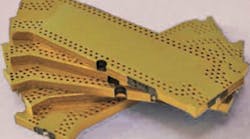BANDPASS FILTERS can cure a great many ills in communications systems and other high-frequency applications. Of course, every requirement is different; standard filter products usually fall short in delivering suitable passband frequency range, or stopband rejection, or even passband amplitude ripple. Fortunately, models in a new line of surface-mount-technology (SMT) bandpass filters from Synergy Microwave Corp. can be specified with passband frequencies from 8 to 20 GHz in 5 to 10% bandwidths. As a result, they can clean up a wide range of signals from X-band through Ku-band frequencies (see figure).
An ideal bandpass filter would pass all desired signals in a target frequency range and reject all signals outside of the passband, with extremely sharp filter skirts at the boundaries of the passband and the rejection bands. In reality, sharp transitions between stopbands and a bandpass filter's passband are difficult to achieve because of the finite time constants of the sections in the filter.
An ideal bandpass filter would also exhibit a complete flat passband, with minimal variation in amplitude response throughout the passband of the filter. Again, this is difficult to achieve in reality, and most filters will suffer some amount of amplitude variation or ripple in the passband. Also, while it may be considered ideal to achieve infinite rejection of unwanted signals outside of the bandpass filter's passband, most practical filters require a certain band of frequencies known as the "rolloff" regionto reach the final level of rejection that is applied to unwanted signals. That amount of rejection may be 40 dB or so.
Synergy Microwave Corp. has supplied standard bandpass filters in small housings or surface-mount packages for some time, including models in the FNS, FBS, and FIS series, with low passband ripple and 1-W power-handling capability. While these and the company's other standard bandpass, lowpass, and highpass filters are compact solutions for a variety of applications, such as intermediate-frequency (IF) filtering, these filters do not extend to X- and Ku-band frequencies for circuit and system designers faced with non-standard frequency ranges and requirements. For that reason, Synergy recently announced its capabilities in custom bandpass filters, with its model BPF800020000 serving as a form of "template" for those interested in specifying a custom bandpass filter. These custom surface-mountable bandpass filters, which are designed and developed at Synergy Microwave Research GmbH, can be specified for passbands from 8 to 20 GHz (X-band through Ku-band frequencies) with passband bandwidths from 5 to 10% of the center frequency.
The insertion loss of these custom filters is dependent on frequency and bandwidth, but ranges from as low as 1 dB at lower frequencies and narrower passbands to as high as 3.5 dB at the highest frequencies and widest passbands. The ripple performance of these filters is outstanding, with maximum ripple for any passband specified at 0.5 dB. The center-frequency drift is also impressive (almost nonexistent, in fact) at only 0.6% across an operating frequency range of −35 to +85C. The maximum selectivity for these custom bandpass filters, defined as the ratio of the bandwidth for 20-dB signal loss to the bandwidth for 3-dB signal loss, is 1.35:1.
The size of these surface-mount filters depends on frequency and bandwidth. Some of these filter designs were developed initially for internal use within frequency synthesizers. As such, they were developed for minimal passband insertion loss at a fraction of the size. The custom bandpass filters are built to handle input power levels to +30 dBm (1 W). For all of the custom filter designs, the VSWR is less than 2.0:1. Filters can be designed for both 50- and 75-Ω environments.

